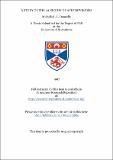Files in this item
A study of the 2A region of aphthoviruses
Item metadata
| dc.contributor.advisor | Gani, D. (David) | |
| dc.contributor.author | Donnelly, Michelle L. L. | |
| dc.coverage.spatial | 223 p. | en_US |
| dc.date.accessioned | 2018-06-11T11:27:00Z | |
| dc.date.available | 2018-06-11T11:27:00Z | |
| dc.date.issued | 1997 | |
| dc.identifier.uri | https://hdl.handle.net/10023/13890 | |
| dc.description.abstract | The proteins encoded by foot-and-mouth disease virus are expressed in the form of a polyprotein, which is processed by virus-encoded proteases to yield the mature viral proteins. The focus of this thesis is the 18 amino acid 2A region of foot-and-mouth disease virus (FMDV), which is (together with the first proline residue of 2B) capable of mediating a primary cleavage at its own carboxy-terminus, between the structural and replicative viral proteins. It was proposed that the 2A region performed this event via a novel proteolytic mechanism. Vectors encoding the FMDV 2A region, in frame, between two foreign gene sequences were constructed to allow the 2A region to be investigated in isolation from the rest of the virus proteins using in vitro translation systems. Detailed quantitative densitometric analyses of the translation products were carried out, which suggested non-stoichiometric expression of the two cleavage products. Single and multiple site-directed mutations were made to the 2A sequence and the activities of the resultant 2A regions determined to establish the identity of functional amino acid residues. The effect of the surrounding foreign protein sequence and the inclusion of progressively longer wild-type sequences prior to 2A was also examined. The carboxy-termini of cardiovirus 2A regions show significant sequence similarity to the FMDV 2A region and are known to mediate a similar primary cleavage. The cleavage activities of the carboxy-termini of cardiovirus 2A regions were compared to that of the FMDV 2A region and found to equally capable of mediating cleavage. The activity of FMDV 2A region was tested in prokaryotes and was found to be inactive. These studies indicated that the 2A cleavage was not a proteolytic cleavage, but more likely a translational effect. A new model for 2A-mediated activity is presented. | en_US |
| dc.language.iso | en | en_US |
| dc.publisher | University of St Andrews | |
| dc.subject.lcc | QR460.A6D7 | |
| dc.subject.lcsh | Viral proteins | |
| dc.title | A study of the 2A region of aphthoviruses | en_US |
| dc.type | Thesis | en_US |
| dc.type.qualificationlevel | Doctoral | en_US |
| dc.type.qualificationname | PhD Doctor of Philosophy | en_US |
| dc.publisher.institution | The University of St Andrews | en_US |
This item appears in the following Collection(s)
Items in the St Andrews Research Repository are protected by copyright, with all rights reserved, unless otherwise indicated.

